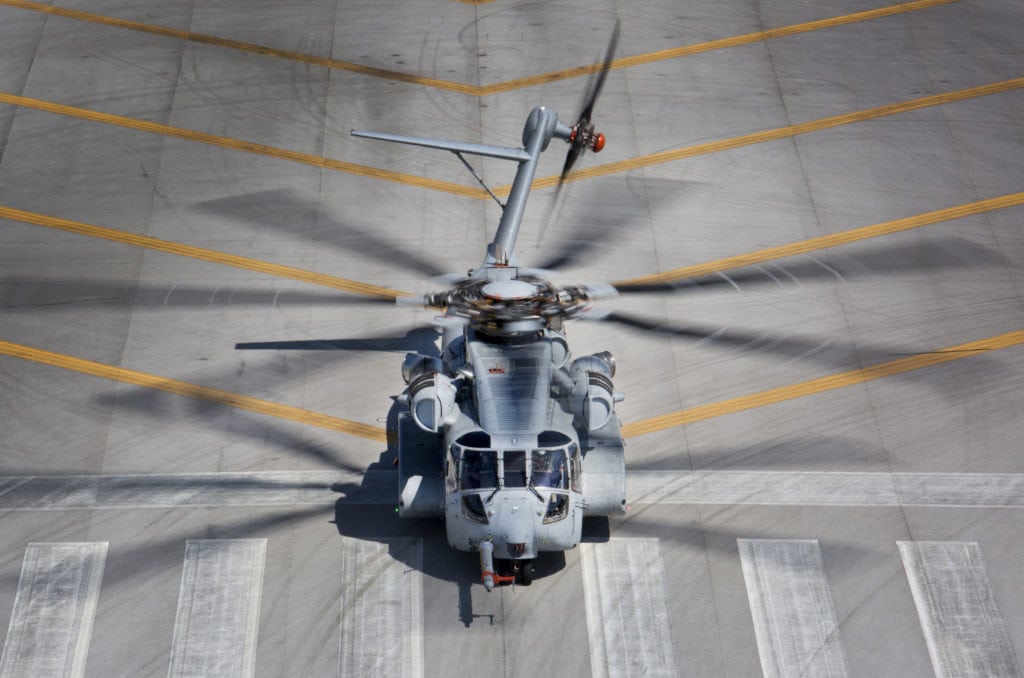
A Sikorsky CH-53K King Stallion lands after a test flight in West Palm Beach, Florida. U.S. Marine Corps photo by Lance Cpl. Molly Hampton
A key CH-53K test aircraft faces certain death this summer has Lockheed Martin spooling up initial production of that new heavy-lift helicopter for the U.S. Marine Corps.
The U.S. Defense Dept. yesterday approved that contractor to begin low-rate initial production (LRIP) of the King Stallion, the Sikorsky-designed successor to the Marines’ CH-53E. Four test aircraft have accumulated more than 430 hours in flight tests at Sikorsky’s West Palm Beach, Florida, facility. But key parts of the testing that supported the positive LRIP decision by the Defense Acquisition Board was performed with the ground test vehicle.
The head of the Naval Air Systems Command’s Heavy Lift Helicopters Heavy Lift Helicopters Program Office (PMA-261), USMC Col. Henry Vanderborght, explained that the ground test vehicle “is a fully flyable CH-53K bolted to the ground” at the West Palm Beach facility. Lockheed Martin’s VP for CH-53K programs, Michael Torok, said, “The ground test vehicle has been leading the whole test program from the beginning.”
The pair provided an update on development of the CH-53K, and operations of the CH-53E is intended to succeed at the Navy League’s Sea Air Space Exposition south of Washington April 3.
In addition to achieving substantial improvements in aircraft performance, the USMC aims to set new standards for rotorcraft operating costs with the King Stallion. A key contributor toward that goal is an intensified effort by that service and Sikorsky to scrutinize operational data from the fielded CH-53E, using health and usage monitoring system (HUMS) capabilities and other analytical tools, to establish comprehensive baseline against which the Kilo can be monitored, Vanderborght and Torok explained. The -53E information is supplemented by data from operations of the -53K test aircraft.
That effort, under the U.S. Navy’s Fleet Common Operating Environment initiative, also aims to identify maintenance and service lessons from the Echo that might be applied to the new heavy-lifter fleet.
Drawing on the onboard avionics capabilities of the two types, the effort has the potential to move the CH-53K closer to an on-condition maintenance program.
Since it began operating in 2013, they said, the ground test vehicle has accumulated more than 500 hours of run time. It has pulled power loads on the CH-53K’s three 7,500-shp GE38-1B engines and dynamic components exceeding those expected be seen in a flying aircraft. That vehicle is still continuing to run, testing the endurance of the King Stallion’s design, structure and systems. “It’s really been a great risk-reduction vehicle,” Torok said.
Once that testing is completed later this year, the ground test vehicle will be taken out to Naval Air Weapons Station China Lake, about 100 nautical miles north-northeast of Los Angeles. There it will serve as the CH-53K program’s live-fire test asset.
“It will be shot to death to prove the last capabilities” of the new heavy-lifter’s design, Torok said.
This report was originally published by Rotor & Wing International. Some content has been added.